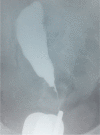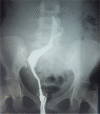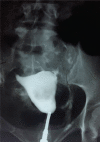Hysterosalpingographic (HSG) Pattern of Infertility in Women of Reproductive Age
- PMID: 29142446
- PMCID: PMC5672723
- DOI: 10.4103/jhrs.JHRS_121_16
Hysterosalpingographic (HSG) Pattern of Infertility in Women of Reproductive Age
Abstract
Background: Infertility is a complex disorder with significant medical, psychological and economic problems.
Aims: The aim of the study is to evaluate the structural abnormalities of the uterus and fallopian tubes in infertile women as elucidated by hysterosalpingography.
Setting and design: A retrospective study, conducted at the Radiology and Obstetric and Gynaecologic Departments of a tertiary health care institution.
Materials and methods: Evaluation of all consecutive patients in whom hysterosalpingographic (HSG) was performed for infertility between July 2013 and June 2015 in the Department of Radiology. For the biodata, indications for the investigation and the HSG findings were obtained.
Statistical analysis: The data were analyzed using IBM Statistical Package for the Social Sciences (SPSS Inc., Chicago, IL, USA) for Windows, version 20 software.
Results: A total of 299 patients were evaluated. Of these, 250 were for infertility with primary and secondary infertility constituting 18.4 and 81.6%, respectively. Seventy percent of the cases for infertility had abnormalities on the HSG. Normal uterine cavity was found in 123 (49.2%) cases. Uterine filling defects were the most common uterine abnormality. Fallopian tube occlusion, loculated contrast material spillage and hydrosalpinx were more common on the right, and bilateral tubal occlusion was seen only in 11.2%. All cases of intravasation were associated with either unilateral or bilateral fallopian tube blockage or irregularity of the uterus.
Conclusion: There was a high incidence of tubal disease in the women presenting with infertility. This was commonly as a result of infection and inflammatory process. This study showed that HSG is very vital in detecting birth canal pathologies; hence, the facility for this important procedure, especially fluoroscopy, should be made available in the health centres for adequate assessment of the women with infertility.
Keywords: Contrast material; fallopian tube; fluoroscopy; hysterosalpingography; infertility; uterus.
Conflict of interest statement
There are no conflicts of interest.
Figures








References
-
- Pundir J, El Toukhy T. Uterine cavity assessment prior to IVF. Womens Health. 2010;6:841–8. - PubMed
-
- Abubakar AP, Yusuf TS. The profile of infertility in a teaching hospital in North West Nigeria. Sahel Med J. 2014;17:7–11.
-
- Evers JL, Collins JA. Assessment of efficacy of varicocele repair for male subfertility: A systemic review. Lancet. 2003;361:1849–52. - PubMed
-
- Okonofua FE. Infertility in Sub-Saharan Africa. In: Okonofua F, Odunsi K, editors. Contemporary Obstetrics and Gynaecology for Developing Countries. Benin City, Nigeria: WHARC; 2003. pp. 128–56.
-
- Ogunniyi SO, Makinde OO, Dare FO. Abortion related deaths in Ile-Ife, Nigeria. Afr J Med Med Sci. 1999;19:271–4. - PubMed
LinkOut - more resources
Full Text Sources
Other Literature Sources
Medical
